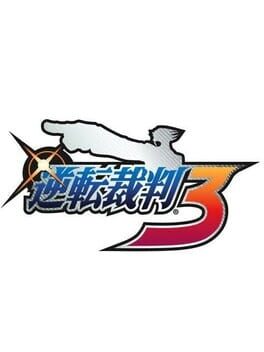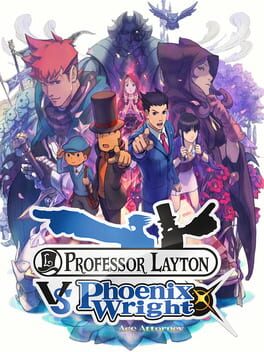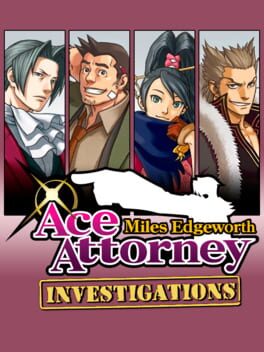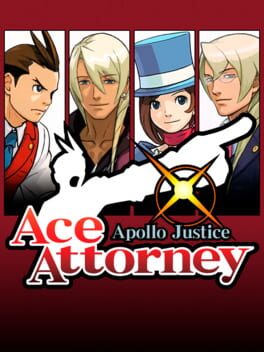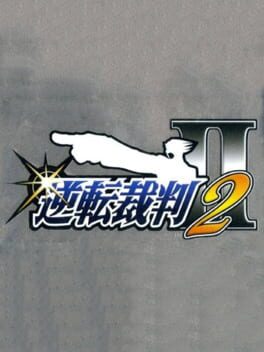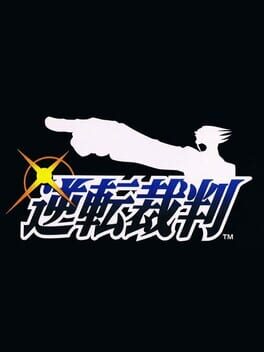The third installment of the Gyakuten Saiban/Ace Attorney series of text adventure video games. It is the last installment in the Gyakuten Saiban Trilogy. In addition to featuring three episodes in which Phoenix Wright faces off against a mysterious new prosecutor named Godot, the game also features the first two cases of Mia Fey's law career. Like the other two games in the trilogy, it was first a Game Boy Advance exclusive title and only released in Japan (until the Nintendo DS port in 2007).
Also in series
Reviews View More
Bringing my time with the original Ace Attorney trilogy to a close, I finally finished up with the last of the GBA games. I certainly remembered enjoying this one significantly more than the second game when I was younger, but with how much I’d clearly forgotten about the second game, I didn’t want to assume that I’d remembered this game anything close to accurately either XD. That said, I ended up really enjoying my time with it. It took me about 25-ish hours to play through the Japanese version of the game on real hardware via my GameBoy Player.
This is the third game focusing on the adventures of our titular Ace Attorney, Phoenix Wright. Introducing yet another new mysterious prosecutor, Godot, this entry brings the trilogy to a close by wrapping up the major plot threads left by the previous two games. Those who read my review of Ace Attorney 2 will be no stranger to just how much I disliked the writing in that game, and I was very much prepared for this game to ultimately be just as much of a failure as that one. No matter how positively I remembered this one, there was no telling how much bad stuff I’d missed in my last playthrough eight years ago.
Thankfully, my memory was by and large quite accurate! While this game’s writing certainly isn’t perfect (with the homophobic stereotype character and some more than slightly problematic age-gap relationship stuff being stand out examples to that point), this game seems to really go out of its way to improve on basically everything the second game suffered so badly with. Returning characters are lessened down significantly, and those who do return do so for reasons that feel important and relevant to their characters. Women overall are written WAY better in particular, and they feel much better represented with a much better depth and variety of character than they had had in the previous two games. The sense of humor has been tuned far better in this game as well. While we’re not completely free of comedy through cruelty for the sake of cruelty by any means, it is far less prevalent as a source of comedy than it was in the last game and it lets the better written humor shine that much brighter.
The fundamentals of writing are also thankfully back to a familiar strength from the first game as well. This game has a much stronger and more deliberate meta-narrative running throughout it, and it leads to a much stronger conclusion as a result. With major themes of what it means to trust someone and what who we fight for says about who we are, you can really tell that this game had a lot more time and effort put into it than the last game managed to. While it’s certainly an unfortunately flawed game in the places that shine less well, it was still a narrative I enjoyed a lot and feel was really well done. While it may have lower lows than the first game did, those lows are not only quite infrequent, but they’re easily outweighed by just how frequent and high the highs of the narrative are.
The mechanics and puzzle design have also thankfully been polished up very significantly since the last game as well. There really aren’t any new mechanics, with the health bar and psycho-lock systems and such returning just as they were in the second game, but what is here has been polished up VERY significantly since the last game, and they’re far more fun as a result. The signposting and overall logic have been improved to the point that I never even needed to look up the solutions to any puzzles to make it to the end of the game~! (Something I was at least a little proud of myself for). A big reason why the puzzles in this game are so much better, though, is that we have finally gotten a reasonable save and penalty system.
Where the second game only had temporary saves mid-chapter and hard checkpoints only between chapters (so if you died, it was back to the last checkpoint, which could be more than half an hour before where you’re at), this game finally makes those temporary saves become their own hard checkpoints, effectively giving you the ability to save and load at will. This means you have much more leeway to trial-and-error your way past a difficult puzzle you’re stuck on, and it’s far less frustrating to hit a puzzle you just can’t quite solve. Another feature that makes the whole game just better is that we finally have a speed-up button for the dialogue. While it isn’t an outright skip button, holding the B button to make text fly by was SUCH a badly needed feature, it’s kinda amazing that it took them three games to add it ^^;. Be that as it may, it’s still better late than never, and this game is far better for its presence.
The presentation is still very much the GBA, but this is the GBA of 2004, not the GBA of 2001 and 2002 as the first two games had to deal with. As a result, not only do we have some of the best looking and strongest designed character sprites we’ve ever had (and a lot of my favorite character designs in the trilogy at that), but we also have SUCH better music as a result. The earlier games didn’t have bad music by any means, but you can really tell that the guys at Capcom have gotten a lot more comfortable with this hardware over the past couple of years with just how much more technical these tracks are. Songs like Tigre’s theme and Mask Demasque’s theme are easily two of my favorite tracks in the whole trilogy, but they’re standing atop a mountain of other great songs on top of that. My only real complaint about the aesthetics are that we’re reusing quite so many things from game to game that older music and especially sprites can kinda stand out and look less than nice compared to the nicer newer stuff (Mia’s original sprite in particular is one I’ve never been a huge fan of, and it looks even more rough next to just how nice everything else looks here).
Verdict: Highly Recommended. This is a sequel to a quality that the original Ace Attorney really deserved. With as wonderful a presentation as ever and writing to a quality either at or better than what they’d ever done before, this completely blows Ace Attorney 2 out of the water, and that’s absolutely not just because of the mechanical touch-ups for quality of life features. Had I played a version that had the extra fifth case added to the first game, perhaps I’d feel differently, but with the versions I played and the language I played them in, this is definitely my favorite of the original trilogy on GBA. It might go without saying at this point in the review, but this is absolutely not a game to miss out on if you like logical deduction puzzles or are just a visual novel fan in general~.
This is the third game focusing on the adventures of our titular Ace Attorney, Phoenix Wright. Introducing yet another new mysterious prosecutor, Godot, this entry brings the trilogy to a close by wrapping up the major plot threads left by the previous two games. Those who read my review of Ace Attorney 2 will be no stranger to just how much I disliked the writing in that game, and I was very much prepared for this game to ultimately be just as much of a failure as that one. No matter how positively I remembered this one, there was no telling how much bad stuff I’d missed in my last playthrough eight years ago.
Thankfully, my memory was by and large quite accurate! While this game’s writing certainly isn’t perfect (with the homophobic stereotype character and some more than slightly problematic age-gap relationship stuff being stand out examples to that point), this game seems to really go out of its way to improve on basically everything the second game suffered so badly with. Returning characters are lessened down significantly, and those who do return do so for reasons that feel important and relevant to their characters. Women overall are written WAY better in particular, and they feel much better represented with a much better depth and variety of character than they had had in the previous two games. The sense of humor has been tuned far better in this game as well. While we’re not completely free of comedy through cruelty for the sake of cruelty by any means, it is far less prevalent as a source of comedy than it was in the last game and it lets the better written humor shine that much brighter.
The fundamentals of writing are also thankfully back to a familiar strength from the first game as well. This game has a much stronger and more deliberate meta-narrative running throughout it, and it leads to a much stronger conclusion as a result. With major themes of what it means to trust someone and what who we fight for says about who we are, you can really tell that this game had a lot more time and effort put into it than the last game managed to. While it’s certainly an unfortunately flawed game in the places that shine less well, it was still a narrative I enjoyed a lot and feel was really well done. While it may have lower lows than the first game did, those lows are not only quite infrequent, but they’re easily outweighed by just how frequent and high the highs of the narrative are.
The mechanics and puzzle design have also thankfully been polished up very significantly since the last game as well. There really aren’t any new mechanics, with the health bar and psycho-lock systems and such returning just as they were in the second game, but what is here has been polished up VERY significantly since the last game, and they’re far more fun as a result. The signposting and overall logic have been improved to the point that I never even needed to look up the solutions to any puzzles to make it to the end of the game~! (Something I was at least a little proud of myself for). A big reason why the puzzles in this game are so much better, though, is that we have finally gotten a reasonable save and penalty system.
Where the second game only had temporary saves mid-chapter and hard checkpoints only between chapters (so if you died, it was back to the last checkpoint, which could be more than half an hour before where you’re at), this game finally makes those temporary saves become their own hard checkpoints, effectively giving you the ability to save and load at will. This means you have much more leeway to trial-and-error your way past a difficult puzzle you’re stuck on, and it’s far less frustrating to hit a puzzle you just can’t quite solve. Another feature that makes the whole game just better is that we finally have a speed-up button for the dialogue. While it isn’t an outright skip button, holding the B button to make text fly by was SUCH a badly needed feature, it’s kinda amazing that it took them three games to add it ^^;. Be that as it may, it’s still better late than never, and this game is far better for its presence.
The presentation is still very much the GBA, but this is the GBA of 2004, not the GBA of 2001 and 2002 as the first two games had to deal with. As a result, not only do we have some of the best looking and strongest designed character sprites we’ve ever had (and a lot of my favorite character designs in the trilogy at that), but we also have SUCH better music as a result. The earlier games didn’t have bad music by any means, but you can really tell that the guys at Capcom have gotten a lot more comfortable with this hardware over the past couple of years with just how much more technical these tracks are. Songs like Tigre’s theme and Mask Demasque’s theme are easily two of my favorite tracks in the whole trilogy, but they’re standing atop a mountain of other great songs on top of that. My only real complaint about the aesthetics are that we’re reusing quite so many things from game to game that older music and especially sprites can kinda stand out and look less than nice compared to the nicer newer stuff (Mia’s original sprite in particular is one I’ve never been a huge fan of, and it looks even more rough next to just how nice everything else looks here).
Verdict: Highly Recommended. This is a sequel to a quality that the original Ace Attorney really deserved. With as wonderful a presentation as ever and writing to a quality either at or better than what they’d ever done before, this completely blows Ace Attorney 2 out of the water, and that’s absolutely not just because of the mechanical touch-ups for quality of life features. Had I played a version that had the extra fifth case added to the first game, perhaps I’d feel differently, but with the versions I played and the language I played them in, this is definitely my favorite of the original trilogy on GBA. It might go without saying at this point in the review, but this is absolutely not a game to miss out on if you like logical deduction puzzles or are just a visual novel fan in general~.
